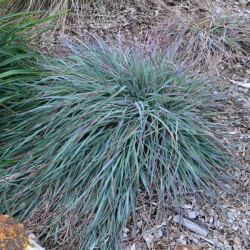Children’s playgrounds have come a long way since the lonely metal slides, swings and mown grass that many of us grew up with. Many modern playgrounds include areas that encourage various types of play. This may include: active; free; quiet; social; imaginative; creative; exploratory and natural play spaces.
Increasingly, children’s playgrounds include natural play spaces, offering a blend of natural areas, environmental features and plants. With good design, a variety of play activity can be catered for in an attractive, fun and living landscape. Such a landscape may include boulders, water and sand, gravel pits, quiet social areas, interesting pathways, musical instruments, bridges as well as structured play equipment.
Choice of plants is critical for success when creating a natural play space and the following should be considered:
• plants should suit the soil and climate of the site;
• the playground is a hectic environment and only hardy plants will survive. It follows that plants that are able to regenerate after damage will be useful;
• plants that can be touched, jumped over or occasionally jumped on will not only survive but be ‘well loved’;
• plants with a variety of different textures, scents, colours, forms and sounds will add to the play experience;
• plants with loose parts such as small logs, leaves, seed pods, fruits, cones etc readily available will be incorporated into play;
• plants of all sizes – trees, shrubs, grasses and ground covers can play a number of roles in a play space;
• avoid plants that have poisonous parts or cause allergic reactions; and likewise
• avoid plants with sharp or prickly parts.
Australian ornamental grasses are well suited to natural play spaces and fulfill many of the above requirements.
Dianella varieties are an excellent playground choice for their strappy, arching foliage, purple flowers and bright edible berries. Depending on the variety chosen, their height range of 400 – 700mm make them suitable for bordering play areas and pathways. Dianella’s spread via a rhizome and will therefore recover quickly following damage. Bluedale recommend Dianella ‘Little Jess’ http://www.bluedaleplantsonline.com.au/shop/Ornamental-Grasses/Little-Jess/6/ or ‘Lucia’http://www.bluedaleplantsonline.com.au/shop/Ornamental-Grasses/Lucia/3/ for playground borders, pathways and mass plantings.
Lomandra cultivars with male only flowers (ie non spikey) offer a taller alternative to Dianella and are well suited to natural playspaces. Lomandra ‘Tanika’, ‘Nyalla’, ‘Katie Belles’ and ‘Tropicbelle’ all have non spikey flowers and strappy foliage that can be woven into baskets, platted into rope or generally wrestled in, jumped on and attacked! For more information on Lomandra visit our wholesale website http://www.bluedale.com.au/our-selection/strappy-leaf-plants/lomandra-varieties or buy online http://www.bluedaleplantsonline.com.au
Tussock grasses such as Poa and Pennisetum perform well the harsh conditions of any high use landscape. They have fine foliage and soft flowers. Poa poiformis ‘Kingsdale’ and Poa labillardieri ‘Eskdale’ are cool season grasses, looking at their best in Winter and well suited to cooler climates. Pennisetum alopecuroides ‘Nafray’, ‘Purple Lea’ and ‘Cream Lea’ are all tall (900mm to 1.5m) warm season grasses. Wind blowing Poa and Pennisetum will add an element of movement to the natural playspace. For more on Bluedale’s ornamental grass selection visit http://www.bluedaleplantsonline.com.au/shop/Ornamental-Grasses/
Australian native groundcovers such as Myoporum parvifolium ‘Yareena’ (10cm tall), Hardenbergia ‘Meema’ (30 – 45 cm tall), and Hibbertia scandens (40cm tall) are all well suited to play space areas. Although they will not tolerate pedestrian traffic, they will recover from damage, are not spikey and have attractive flowers. http://www.bluedaleplantsonline.com.au/shop/Ground-Cover-Plants/
In ponds and creekbeds with permanent water, the soft foliage of Carex fascicularis offers an alternative to other water plants, many of which have spiky or sharp foliage.
For further information on the plants recommended visit our website http://www.bluedaleplantsonline.com.au/ and buy online.












